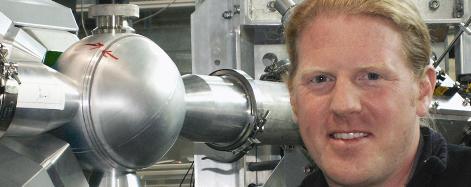
Carl E. Svensson, an associate professor of physics at the University of Guelph and a leader of a pivotal new experiment at TRIUMF, has been awarded the prestigious NSERC E.W.R. Steacie Memorial Fellowship. Dr. Colin Carrie, Parliamentary Secretary of Industry Canada, and Dr. Suzanne Fortier, President of the Natural Sciences and Engineering Research Council (NSERC), presented the award to Svensson and five other recipients at a ceremony in Ottawa on March 17, 2008.
The E.W.R. Steacie Fellowship is one of Canada’s most prestigious science and technology awards. It is named after E.W.R Steacie in honour of his achievements in the science of physical chemistry and his stewardship of the Canadian research program for more than a decade as head of the National Research Council. The winners receive additional funding to support their research, and their universities receive a salary contribution to fund a replacement for the Fellow’s teaching and administrative duties, thus allowing the winners to focus on their research for two years. This occasion marks only the second time that the award has been given for accomplishments in subatomic physics.
Professor Svensson has carved out an enviable reputation in the rarefied world of subatomic physics for both his experimental work and his leadership in designing and building the tools needed to probe the inner workings of atoms and nuclei. His recent work has been as a leader of the cutting-edge research project known as TIGRESS, or the TRIUMF-ISAC Gamma-Ray Escape Suppressed Spectrometer. TIGRESS is a major new international user facility. It is effectively a giant microscope that allows scientists to study the nucleus of an atom. It detects gamma rays (very high frequency light) with unprecedented sensitivity, measuring not only the energy of the light but pinpointing their direction of travel as well. It has been designed and built to answer many important questions on nuclear structure using several different reaction mechanisms. Each reaction mechanism accesses different energies, spins, and components of the wave functions, and exposes different features of the nucleus to scientists. Started in 2003, TIGRESS will be completed in 2009, but enough components have been up and running since 2006 for research already to be in full swing.
The University of Guelph is presently an associate member of the TRIUMF consortium.
For more information, please see the NSERC press release.
by Timothy Meyer
TRIUMF's Head of Strategic Planning and Communications
